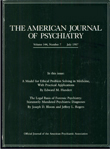I was delighted to receive the third edition of the Manual of Clinical Psychopharmacology for review. My copy of the first edition (published in 1986) is well worn, having seen me through my residency training. I found the second edition (published in 1991) equally helpful, and it still sits on my desk as an often-used reference. The third edition will now take its place. This edition is no different from the first two; it is the most accessible and up-to-date psychopharmacology manual published today.
The narrative remains well written and easy to understand. The editors introduce each section with a concise history of a class of medications, which includes the evolution of our thinking regarding various aspects of practice (e.g., long-term maintenance pharmacotherapy). A brief explanation of the “biochemical effects” of the class of medication follows. In this manual, these explanations are clear, unlike those in some psychopharmacology textbooks and manuals.
The format of the manual has not changed—it is divided into chapters according to “types” of medications (e.g., chapter 3, “Antidepressants,” chapter 4, “Antipsychotic Drugs,” etc.). In this edition, there is much more information on selective serotonin reuptake inhibitors (SSRIs), which reflects our prescribing practice. Chapter 3, “Antidepressants,” has an expanded section on SSRIs, and it includes a new table, “Inhibition of Cytochrome P-450 Isoenzymes by Antidepressants.” This table is useful in helping the reader understand different SSRI-drug interactions (e.g., SSRIs increase the plasma level of some medications). Although the manual is divided into types of medications, there is a suborganization by DSM-IV diagnoses. Thus, one might look at chapter 6, “Anti-Anxiety Agents,” for medications to treat anxiety disorders. In this chapter one would find information on the classes of antianxiety medications—benzodiazepines, barbiturates, etc. Also in this chapter, however, is a thorough section describing SSRIs as anxiolytic agents, with reference to chapter 3 for details concerning dosing, etc. Chapter 9, “Combination and Adjunctive Treatments,” has been updated and expanded to reflect the increased use of SSRIs and anticonvulsant medications for psychiatric disorders.
I was pleased to see that more tables have been added to this edition. The basic tables have been updated and are very useful. They list practical information such as generic and brand names, forms of medication (tablet/capsule, oral concentrate, or parenteral forms), therapeutic dose range, and common or troublesome side effects of a particular class of medication. Other tables include information of clinical importance—table 12-2, “Teratogenic Risks of Psychotropic Medications,” and table 10-1, “Medication Options for Rapid Tranquilization of the Agitated Patient,” are two examples.
This edition has information on many of the new medications—nefaxodone, venlafaxine, mirtazapine, olanzapine, sertindole, risperidone, gabapentin, lamotrigine, zolpidem, naltrexone, and others. The editors report that they intend to update this manual every three years to keep up with the new medications released for use. Given the success of the first three editions, I predict that many of us will be using this manual, and subsequent editions, for many years to come. I highly recommend it for all psychiatrists who prescribe medications.

